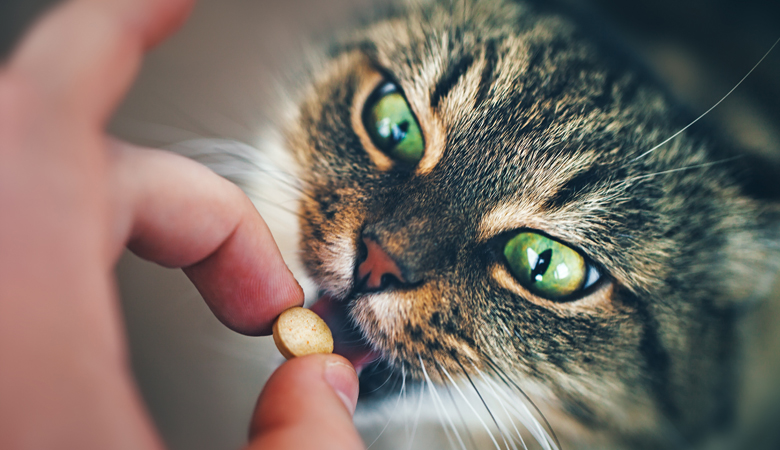Everything you need to know about worming your pet
Written by |
Worming is part of the standard care of your pet. Still, many people have questions about worming their pets. That is why we have created a comprehensive guide for you. If you are looking for a popular worming treatment for dogs or cats then have a look at our full product range Drontal.

What are the different types of worms?
There are various types of worms that can infest (you and) your pet. The most common ones are roundworms, whipworms, tapeworms, hookworms, lungworms and heartworms. Cats and dogs can be infested by roundworms in different ways: by direct intake of eggs or larvae from the area, by intake via prey, via the milk of the female cat and directly via the placenta (only for puppies). A tapeworm infestation, on the other hand, always occurs via a so-called intermediate host: cats and dogs only get infested by the food of their prey or by fleas that are ingested when the animal cleans himself. Whipworm and hookworm infestations occur because eggs from the environment (in the soil) end up on the tongue, and heartworm (Dirofilaria) is spread by mosquitoes. Thankfully, the latter is rare here, but it is more common in the south of Europe. You should definitely be prepared for this if you take your dog on holiday with you!
The importance of regular worming treatments
Worms can cause a wide variety of symptoms in your cat or dog. These depend on the type of worm infestation and the severity of the infestation. In low numbers of worms, infestations can sometimes run their course without symptoms. This may be the case for roundworms, tapeworms and whipworms. In other cases, vague symptoms can be observed, such as weight loss, poor condition, a dull coat, anal itching and mild gastrointestinal problems. Roundworms can also cause the notorious “worm belly” in puppies. Hookworms and whipworms can lead to more distinct symptoms, such as diarrhoea (with bleeding), anaemia and/or weight loss. As the name suggests, heartworm causes heart problems, with the main symptoms being breathlessness, coughing, reduced stamina and weight loss.
Aside from the fact that you want to prevent these problems in your cat or dog, worming your pet is also very important for your own health! Roundworm infestations especially (and to a much lesser extent hookworm infestations) also occur in humans. Young children, in particular, are often infected by pets, because they ingest worm eggs whilst playing in a sandpit or in the garden.
Frequency of worming treatments
Guidelines have been created for using worming treatments on pets. The ESCCAP (European Scientific Counsel Companion Animal Parasites), a group of frontrunning, specialist veterinarians and parasitologists, is a non-profit organisation that works on these guidelines. For dogs, they advise the following: puppies should be treated at the age of 2, 4, 6 and 8 weeks, and then monthly until they are 6 months old. Dogs should be treated 4x per year thereafter. For hunting dogs or dogs in areas where the fox’s tapeworm occurs, more frequent worming treatments may be necessary. You should consult with your veterinarian about this. For kittens, it is advised that you start worming them at the age of 3, 5 and 7 weeks, followed by a monthly treatment up to the age of 6 months. From the age of 6 months, it is recommended that cats are treated 4 times per year.
What about indoor cats?
Research shows that around 20% of all cats with roundworm infestations are exclusively kept indoors. These animals have been indirectly infected by their owners. Worm eggs can be brought into the house on the bottom of your shoes, among other things. That is why indoor cats must also be wormed!
Please note, worm eggs are not visible in your pet’s faeces with the naked eye. In case of an infestation, you often won’t notice (dead) worms in your pet’s faeces until after treatment. An exception is the parts of tapeworms. These look like grains of rice and can sometimes be found in the coat or faeces. If in doubt, you can always ask your veterinarian to perform a faecal examination!
Timing of worming treatments
For the largest part of the year, the exact time of a worming treatment is not important. Your pet can be infested in any season. It is recommended that you give your pet a worming treatment approximately 2 weeks before their annual immunisation. This is because worm infestations adversely affect your pet’s immune system, so the reaction to the immunisation will not be as strong, as the number of antibodies that are produced in those cases is often lower than for animals that have recently had a worming treatment.
What else can you do to prevent this?
Hygiene!
Aside from the actual worming treatment, there are other things you can do to prevent your pet from coming into contact with worm eggs. These include picking up your pet’s faeces (of course you should not dispose of them in your organic waste or on your compost heap), cover sand pits, and regularly and thoroughly wash your hands. This is especially important before meals and after gardening.
As indicated above, tapeworm infestations can be caused by fleas as intermediary hosts. That is why flea prevention is also important alongside regular worming treatments. Products that can be used for this include Midaspot.
Worming products
At Vetsend, you can buy various types of worming treatments. For puppies and kittens, we recommend Drontal Oral Suspension for Puppies, for adult dogs we recommend Drontal Plus for Dogs, and for cats, you can use Drontal for Cats.



